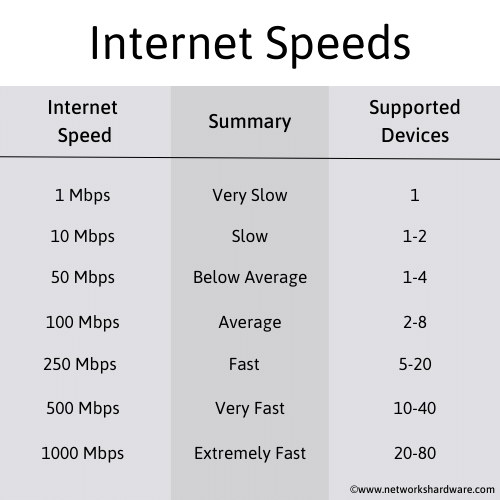

Video conferencing: virtually instant for standard definition, 1-2 seconds of buffering time for high definition.Online gaming: virtually instant (depending on the game and device).Streaming video in 4K/Ultra HD: 6-10 seconds of buffering time.Streaming video in high definition (HD): 3-6 seconds of buffering time.Streaming video in standard definition (SD): 1-2 seconds of buffering time.
 Browsing the web, checking email, and social media: virtually instant. With a speed of 100 Mbps, users can enjoy fast and reliable internet that can accommodate various online activities. In fact, the FCC updated its definition of broadband internet to include a minimum download speed of 100 Mbps in July 2022, citing the increasing demand for higher internet speeds. However, as a general internet speed recommendation, a speed of 100 Mbps is considered good for today's standards. This suggests that the majority of US households are currently experiencing internet speeds that exceed the FCC's minimum standard.ĭetermining how much Mbps you need is dependent on your internet usage. However, according to a 2021 report by Ookla, the average download speed for fixed broadband internet in the US was around 135 Mbps, with an average upload speed of 52 Mbps. These speeds are sufficient for common online activities like web browsing, video conferencing, and HD video streaming. By understanding what internet speed is necessary for different activities, you can optimize your internet connection and ensure a smooth and uninterrupted online experience.īack in 2015, the Federal Communications Commission set the standard for internet speeds in the US to a minimum download speed of 25 Mbps and a minimum upload speed of 3 Mbps. This begs the question, what is a good internet speed to accommodate this shift? In this article, we'll provide an overview of internet speeds and what speed you need for various activities, such as browsing the web, streaming videos, and online gaming. With the increasing use of devices that are connected to the internet, this scenario is becoming increasingly common in today's society.Īs more and more people use multiple devices to access the internet, it creates a larger demand for bandwidth.
Browsing the web, checking email, and social media: virtually instant. With a speed of 100 Mbps, users can enjoy fast and reliable internet that can accommodate various online activities. In fact, the FCC updated its definition of broadband internet to include a minimum download speed of 100 Mbps in July 2022, citing the increasing demand for higher internet speeds. However, as a general internet speed recommendation, a speed of 100 Mbps is considered good for today's standards. This suggests that the majority of US households are currently experiencing internet speeds that exceed the FCC's minimum standard.ĭetermining how much Mbps you need is dependent on your internet usage. However, according to a 2021 report by Ookla, the average download speed for fixed broadband internet in the US was around 135 Mbps, with an average upload speed of 52 Mbps. These speeds are sufficient for common online activities like web browsing, video conferencing, and HD video streaming. By understanding what internet speed is necessary for different activities, you can optimize your internet connection and ensure a smooth and uninterrupted online experience.īack in 2015, the Federal Communications Commission set the standard for internet speeds in the US to a minimum download speed of 25 Mbps and a minimum upload speed of 3 Mbps. This begs the question, what is a good internet speed to accommodate this shift? In this article, we'll provide an overview of internet speeds and what speed you need for various activities, such as browsing the web, streaming videos, and online gaming. With the increasing use of devices that are connected to the internet, this scenario is becoming increasingly common in today's society.Īs more and more people use multiple devices to access the internet, it creates a larger demand for bandwidth. 
You're streaming a video on your iMac, working on your iPad, checking your social media notifications on your iPhone, and receiving text messages on your Apple Watch all at the same time.

Imagine you're a tech-savvy individual who owns an iMac, an iPad, an iPhone, and an Apple Watch.








 0 kommentar(er)
0 kommentar(er)
